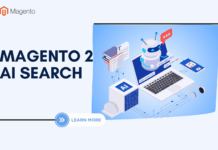
With many technologies entering the world of eCommerce, such as cloud, AR/VR, artificial intelligence, blockchain, etc., it is increasingly becoming an arena of competition for retailers. And their struggle to survive the cutthroat competition is getting more exhaustive daily.
Consequently, the current era of digital transformation is facing a paradigm shift towards headless commerce. Hence, many online retailers are now proceeding towards eCommerce app development with a headless approach.
Online shopping is a widely preferred choice of people, and that goes beyond desktop websites to small mobile screens. Therefore, many businesses hire a headless commerce app development company since developing a mobile app with a headless approach offers the prevalent benefit of customizing the front end. Not only that, there are many ways it can revolutionize the world of mobile app development that we will understand in this blog.
Table of Contents
I. What is headless commerce, and how does it differ from traditional development?
Before diving into headless commerce, let’s understand the front-end and back-end of app development.
| Backend Overview | Web ServerApplication ServerDatabase |
| Frontend Overview | Exploring the Product CatalogAdding Items to Their Wish Lists or Shopping Carts; Signing Up on the Website. |
In the traditional way of developing a mobile app, a single platform or system manages the creation of both the front-end and back-end. Hence, the front-end and back-end of eCommerce applications are tightly coupled; this means that any changes or updates made to the front-end must also be implemented in the back-end.
In headless commerce, the front end is decoupled from the back end, meaning designers have the power to customize the front end separated from the back end. Hence, it provides them with the flexibility to offer a unique experience to your users as per their requirements and demands.

When developing an eCommerce store with a Headless approach, you are not forced to remodel or leave the front end within a tightly coupled user experience. Furthermore, you can call all the complex e-commerce functionality from the backend via a RESTful API.
Businesses looking to build an interactive user interface for their complex requirements and ordering processes can move for this next-generation architecture. Also, it will facilitate customization to address the growing or scaling business needs.
II. Why Use Headless Commerce For eCommerce Store Development?
As mentioned above, headless commerce decouples the front end from the back end, providing the freedom to customize the brand guidelines. Hence, you can offer an enriched customer experience with a headless approach.
Let’s understand a lot of benefits you can get from it:
- Enhanced Flexibility
Since the front end is decoupled from the backend in headless commerce, it enables developers to choose suitable tools and technologies for building both these components seamlessly. Hence, it facilitates flexibility in the development process, optimizing performance, speed, and scalability.
- High Scalability
The headless commerce architecture provides better performance and scalability benefits, enabling the back-end and front-end to scale independently. Hence, businesses can enhance their backend functionality for high-volume transactions without affecting the user experience. Furthermore, the eCommerce application can be tailored to provide fast experiences, ensuring it can handle high volumes of traffic efficiently.
- API Delivered Commerce

In mobile app development, the headless approach functions with Application Programming Interfaces (APIs), which integrate the front-end to the back-end. Acting as a bridge between these two components, API enables communication with each other, making sure the back end can send data and content to the front end, displaying it on the user’s screen. However, various systems can be integrated using APIs, including e-commerce platforms such as Shopify, content management systems (CMS), and customer relationship management (CRM) systems.
- Faster Time-to-Market
Separating front-end and back-end in headless commerce enables developers to implement changes, updates, and new features quickly and precisely where it is targeted. This helps businesses to reduce time-to-market.
- Improved Performance
Headless commerce is said to offer faster loading times, ensuring better mobile application performance. It allows developers to optimize the front end for performance and usability, specifically for mobile devices, guaranteeing responsive applications.
- Better Integration Capabilities
Headless commerce is known for its integration capabilities and for building an interactive eCommerce store, so this benefit comes in handy. Hence, seamlessly integrating it with third-party applications and services can enable a unified and consistent experience across different channels and devices with headless commerce.
- Omnichannel Experience
Creating a true omnichannel experience is a must in this era when the audience uses various devices and operating systems. This is where easy integration capabilities of headless commerce come into play, delivering content across multiple channels and touchpoints.
III. Step-by-Step Guide to Building an eCommerce Store With Headless

Want to build a user-friendly eCommerce mobile app with a headless development approach? Follow the below steps to understand the process of headless commerce app development.
- Define Business Requirements: Understand the customer preferences and buying behaviors to define the suitable business model and app development requirements.
- Select the Tech Stack: The next step is to choose the suitable technologies, tools, and frameworks to work with. Microservices, API gateway, containerization, serverless computing, event-driven architecture, API-first design, cloud-native computing, DevOps, and analytics are some of the components of the tech stack you can select.
- Choose the Headless eCommerce Platform: Shopify, Magento, WooCommerce, BigCommerce, etc., are some of the eCommerce platforms that offer healthcare commerce development services.
- Start the Development Process: After gathering all the requirements, defining the app idea, and selecting the framework and technology, you can start designing the application.
- Test and Optimize eCommerce Store: It is essential to ensure that your application functions seamlessly across all the designated devices and operating systems. For that, you must rigorously test your mobile application.
- Launch and Maintain the eCommerce Store: Once your application is ready and you are satisfied with its functionality, you can launch it on the targeted App Store and maintain or update the features and functionality regularly.
IV. Conclusion
Since the shopping habits of people are widely changing, you must look for futuristic trends to implement in your eCommerce store. If you want a well-established eCommerce business, you need to align your business with customer expectations. With headless commerce, you can develop a transformative mobile app, scaling eCommerce platform infrastructure. Hence, you can hire a company that offers headless commerce app development services to explore your app idea and create a business foundation with a creative application to help your company grow.












![[SALE OFF] Discount 30% All Premium Extensions On Christmas And New Year 2025 christmas-and-new-year-2025](https://landofcoder.b-cdn.net/wp-content/uploads/2024/12/christmas-and-new-year-2025-1-218x150.png)






